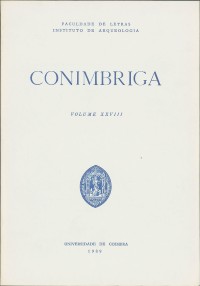Please use this identifier to cite or link to this item:
https://hdl.handle.net/10316.2/45571| DC Field | Value | Language |
|---|---|---|
| dc.contributor.author | Ribeiro, J. Cardim | - |
| dc.date.accessioned | 2019-02-14T11:05:16Z | |
| dc.date.accessioned | 2020-09-23T09:27:45Z | - |
| dc.date.available | 2019-02-14T11:05:16Z | |
| dc.date.available | 2020-09-23T09:27:45Z | - |
| dc.date.issued | 1989 | - |
| dc.identifier.issn | 0084-9189 | - |
| dc.identifier.issn | 1647-8657 (PDF) | - |
| dc.identifier.uri | https://hdl.handle.net/10316.2/45571 | - |
| dc.description.abstract | Um pequeno, mas verdadeiramente interessante monumento epigráfico — uma arula descoberta em Some (distrito de Coimbra) no ano de 1825 e registada por Hübner (C.I.L. II 363) em 1869 — foi recentemente detectado nas reservas arqueológicas da Academia das Ciências de Lisboa. Tornou-se assim possível proceder a uma observação directa da peça, corrigindo-se a leitura apresentada por Hübner e fixando-se a forma do teónimo: VASEGO (dat.). No presente artigo, depois de recordar as circunstâncias do achado, o autor revê uma a uma as diversas opiniões, já publicadas, relativas à interpretação da epígrafe e respectivo teónimo (Hübner, Steuding, Leite de Vasconcellos, Holder, Toutain, Keune, Heichelheim, Blázquez, Encarnação, Alarcão), apresentando depois uma descrição objectiva do monumento e consequente leitura do texto nele gravado, baseadas numa análise minuciosa do próprio original. Em seguida sugere e discute algumas hipóteses possíveis quanto ao significado etimológico do teónimo, acabando por considerar como mais provável a que relaciona Vasegus com o ide. *uesu, ‘bom’. Por fim, indexa várias razões que, conjugadamente, o levam a atribuir a arula a um período compreendido entre finais da primeira metade do séc. III e inícios do séc. IV d.C.. | por |
| dc.description.abstract | A very interesting, although small, epigraphic monument — an arula unearthed at Soure (district of Coimbra) in 1825, and described by Hübner [C.I.L. II 363) in 1869 —-was recently identified as part of the archaeological fund of the Academia das Ciências de Lisboa. This offered an opportunity for reexamination, which allowed to correct the Hübner’s reading, and to fix the form of the theonym: VASEGO [dat.). In the present paper, after remembering the circumstances of discovery of the piece, the author proceeds with a separate review of the different opinions on the contents of the inscription (Hübner, Steuding, Leite de Vasconcellos, Holder, Toutain, Keune, Heichelheim, Blázquez, Encarnação, Alarcão), and presents the analytical study of it, based on direct close scrutiny. Thereafter, some hypotheses on the etymological meaning of the theonym are discussed, that relating Vasegus to IE. *uesu, ’good’, being accepted as the most probable one. Finally, reasons are advanced for the attribution of the arula to the period from the late first half of the 3rd century to the early 4th century A.D. | eng |
| dc.language.iso | por | - |
| dc.publisher | Imprensa da Universidade de Coimbra | - |
| dc.rights | open access | - |
| dc.title | O teónimo Vasegvs | por |
| dc.type | article | - |
| uc.publication.collection | Conimbriga vol. 28 | - |
| uc.publication.firstPage | 121 | - |
| uc.publication.lastPage | 156 | - |
| uc.publication.location | Coimbra | - |
| uc.publication.journalTitle | Conimbriga: Revista de Arqueologia | - |
| uc.publication.volume | 28 | por |
| dc.identifier.doi | 10.14195/1647-8657_28_7 | - |
| uc.publication.orderno | 7 | - |
| uc.publication.area | Artes e Humanidades | - |
| uc.publication.manifest | https://dl.uc.pt/json/iiif/10316.2/45571/236704/manifest?manifest=/json/iiif/10316.2/45571/236704/manifest | - |
| uc.publication.thumbnail | https://dl.uc.pt/retrieve/11553403 | - |
| item.grantfulltext | open | - |
| item.fulltext | With Fulltext | - |
| Appears in Collections: | Conimbriga | |
Files in This Item:
| File | Description | Size | Format | |
|---|---|---|---|---|
| o_teonimo_vasegvs.pdf | 1.35 MB | Adobe PDF |  |
Items in DSpace are protected by copyright, with all rights reserved, unless otherwise indicated.
